Clinician's Guide to Violence Risk Assessment
Jeremy F. Mills, Daryl G. Kroner, and Robert D. Morgan
Hardcovere-bookprint + e-book
Hardcover
orderOctober 27, 2010
ISBN 9781606239841
Price: $49.00242 Pages
Size: 6" x 9"
Presenting a comprehensive framework for conducting a scientifically grounded violence risk assessment, this book is authoritative, current, and practical. The essentials of doing this type of evaluation are reviewed, and available risk appraisal instruments are described for general violence, sexual violence, and spousal violence. The authors provide expert advice on choosing suitable instruments and approaches for particular cases, interpreting the resulting data, and communicating with legal decision makers. A detailed outline shows how to organize assessment findings into an effective final report; a sample completed report is featured in the appendix.
“One of the immediate qualities to this text is its forthright practical orientation in systematically canvassing procedures that the authors advocate for undertaking a professionally comprehensive and, if necessary, legally defensible evaluation of risk in carious formal capacities. This is commendable, in contrast to much of the more academically oriented literature also available on the same topic. Moreover, Mills et al. are refreshingly candid in explicitly acknowledging their own conceptual leanings and thus are 'straightforward regarding [their] bias about how to conduct risk assessments and note differences from other perspectives where they exist'....Professional disagreement and discourse on risk assessment continues unabated to this present day in both the academic as well as professional realms of forensic psychiatry and psychology....Within this framework...Mills, Kroner, and Morgan have produced a cogent practical guide on how such risk assessments may be undertaken, drawing on their own professional expertise as well as a wealth of contemporary literature within the field. Equipped with this information, their text is a valuable guide and one that is likely to minimize the risks for practitioners in undertaking risk assessments in the future.”
—International Journal of Offender Therapy and Comparative Criminology
“When it comes to violence risk assessment, mental health professionals can feel lost in a sea of contradictory claims. Finally, Mills et al. have produced a user-friendly map that provides robust, accurate, even-handed, and readable advice about this crucial task. From rising stars in forensic psychology, this is an outstanding contribution to the field, and one that will have a very long shelf life. Buy this book!”
—Joel A. Dvoskin, PhD, past president, American Psychology-Law Society; Department of Psychiatry, University of Arizona
“This excellent book provides a practical, evidence-based, step-by-step guide to choosing risk assessment instruments, doing a thorough risk assessment, and conveying your conclusions in a user-friendly report. The authors convey a thorough knowledge of the research literature, but it is also clear that they have been in the trenches. This book is a 'must' for novices who work in forensic settings.”
—Phillip Resnick, MD, Department of Psychiatry, Case Western Reserve University
“When mental health clinicians are asked to assess the risk of violence, their determinations have serious implications for both the patient and the public. To aid clinicians in making these important decisions, Mills et al. offer an evidence-based framework for risk assessment. The authors present essential forensic tools substantiated with current research. Their framework for risk assessment does not end with gathering information and formulating opinions; they also include practical guidelines for developing risk management strategies and reporting risk to the court as well as to other stakeholders in the criminal justice and mental health systems. The authors integrate research and clinical knowledge in a manner that provides clinicians with the state of the art and science of risk assessment. A welcome resource.”
—Allan E. Barsky, JD, MSW, PhD, School of Social Work, Florida Atlantic University
Table of Contents
1. Violence Risk Assessment: An Introduction2. Violence Risk Factors
3. Risk Appraisal Instruments
4. Issues in Risk Assessment
5. An Integrated–Actuarial Approach to the Assessment and Management of Risk for Violence
6. The Risk Assessment Process
7. Telling the Story: An Outline for the Report
Appendix. Sample Violence Risk Assessment
About the Authors
Jeremy F. Mills, PhD, CPsych, is a psychologist with a practice in forensic, correctional, and counseling psychology in Kingston, Ontario, Canada. In addition, he serves as Adjunct Research Professor in the Department of Psychology at Carleton University in Ottawa. A Fellow of the American Psychological Association, Dr. Mills’s research interests include violence risk assessment, violence risk communication, and the assessment of suicide risk. Dr. Mills provides consultation and training in the area of violence risk assessment.Daryl G. Kroner, PhD, CPsych, is Assistant Professor in the Department of Criminology and Criminal Justice at Southern Illinois University Carbondale. Previously, he was a prison psychologist. Dr. Kroner’s research interests include correctional mental health, dynamic risk assessment during community supervision, and the social-context aspects of risk assessment.
Robert D. Morgan, PhD, is Associate Professor in the Department of Psychology at Texas Tech University in Lubbock, Texas. In addition, he is Director of Clinical and Forensic Services at Lubbock Regional Mental Health Mental Retardation Center. Dr. Morgan’s research interests include correctional mental health, forensic psychology, and professional development and training.
